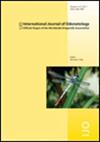森林边缘及其对北温带实验池塘蜻蜓到达的影响
IF 1
4区 农林科学
Q3 ENTOMOLOGY
引用次数: 0
摘要
基质是景观中个体移动但不居住的环境,它可以影响物种的扩散和个体到达栖息地斑块。这个矩阵周围提供庇护或资源的元素可能会影响动物到达栖息地斑块,即使这些斑块在质量上是相同的。在北温带地区,成虫(蜻蜓目:异翅目)在迁徙和扩散过程中经常使用开阔的陆地环境;然而,它们也可以在森林边缘栖息。由于森林边缘对成年蜻蜓的潜在价值,我们测试了与多个森林边缘的池塘邻近性(即连通性)是否与到达的蜻蜓的丰度或多样性呈正相关。我们观察到蜻蜓到达位于加拿大安大略省开阔田野景观中的9个实验池塘点。实验池塘与源池塘和森林边缘的距离不同,森林边缘是蜻蜓的潜在避难所。我们发现,与森林边缘的连通性或与源池塘的距离对到达一个地点的蜻蜓的丰度或多样性没有影响。因此,蜻蜓的扩散并不局限于我们研究的空间尺度(距离源池塘<305米)。此外,蜻蜓似乎没有根据附近森林边缘的数量来区分不同的地点,尽管在一般开放的景观中,所有的地点都至少有一些森林边缘在附近(10-79米)。我们的研究结果为蜻蜓在分散到繁殖栖息地时对景观元素的响应提供了更深入的了解。本文章由计算机程序翻译,如有差异,请以英文原文为准。
Forest edges and their effects on the arrival of dragonflies at north-temperate experimental ponds
The matrix, an environment in the landscape that individuals move through but do not reside in, can affect species dispersal and the arrival of individuals at habitat patches. Elements around this matrix that provide refuge or resources may shape the arrival of animals at habitat patches, even when those patches are equivalent in quality. Adult dragonflies (Odonata: Anisoptera) frequently use open terrestrial environments during movement and dispersal in north-temperate regions; however, they can also roost along forest edges. Because of the potential value of forest edges to adult dragonflies, we tested whether pond proximity (i.e., connectivity) to multiple forest edges was positively related to the abundance or diversity of arriving dragonflies. We observed dragonflies arriving at 9 experimental pond sites located within an open field landscape in Ontario, Canada. Experimental ponds differed in their distance to source ponds and to forest edges, a potential refuge for dragonflies. We found no effect of connectivity to forest edges or distance to source ponds on the abundance or diversity of dragonflies arriving at a site. Dragonfly dispersal was therefore not limited at the spatial scale of our study (<305 m to source ponds). In addition, dragonflies did not seem to discriminate among sites based on the amount of nearby forest edge, although all sites within the generally open landscape had at least some forest edge in close proximity (10–79 m). Our results provide greater insight regarding the decisions that dragonflies make in response to landscape elements while dispersing to reproductive habitats.
求助全文
通过发布文献求助,成功后即可免费获取论文全文。
去求助
来源期刊

International Journal of Odonatology
ENTOMOLOGY-
CiteScore
2.30
自引率
0.00%
发文量
15
审稿时长
>12 weeks
期刊介绍:
International Journal of Odonatology (IJO) is aimed at providing a publication outlet for the growing number of students of Odonata. It will address subjects such as the ecology, ethology, physiology, genetics, taxonomy, phylogeny and geographic distribution of species. Reviews will be by invitation, but authors who plan to write a review on a subject of interest to the journal are encouraged to contact the editor.
 求助内容:
求助内容: 应助结果提醒方式:
应助结果提醒方式:


